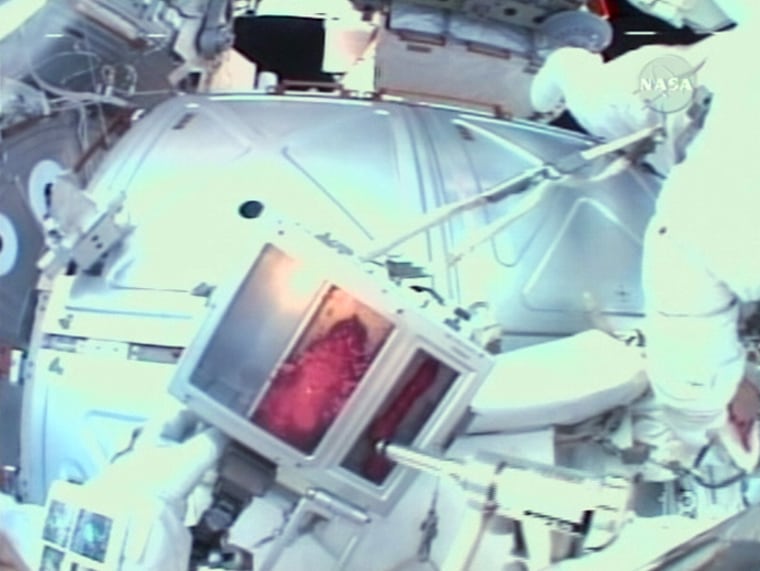Two spacewalking astronauts pulled out a caulk gun and high-tech putty and tested a method for patching shuttle thermal tiles.
It was the fourth spacewalk since Endeavour arrived at the international space station just over a week ago to deliver a robot and the first section of a Japanese lab.
The long-awaited repair test Thursday night was ordered following the 2003 Columbia tragedy in which the shuttle exploded on its return after its wing was gashed at liftoff by a chunk of fuel-tank insulating foam.
Astronaut Michael Foreman — "Mr. Goo" — squeezed the salmon-colored material from the caulk gun-like dispenser and filled holes in deliberately damaged tile samples that were carried up aboard Endeavour. He used a small foam brush to tap down and smooth the putty, but small bubbles kept popping up.
His spacewalking partner, Robert Behnken, floated nearby, wiping excess putty from the nozzle of the caulk gun.
"You are Captain T-Rad, Mr. Goo. You're in control today," astronaut Richard Linnehan called out to Foreman. T-Rad is NASA's name for the caulk gun; it stands for tile repair ablator dispenser.
After a little more testing, Linnehan told Foreman, "You'll be our tile and grout specialist."
"Well, I hope we don't need one," Foreman said. "Good point," Linnehan replied.
Gauging the goo
Even more of a mystery than how the caulk gun would work was how the goo would behave. Engineers were curious about whether bubbles would form and rise to the top as they do on Earth or whether any bubbles would remain inside the material and cause it to swell.
This so-called rising bread-loaf effect could jeopardize a repair and endanger a crew during re-entry.
"It really is like a loaf of bread with all the little bubbles in there," Foreman observed.
Slideshow 12 photos
Month in Space: January 2014
Mission Control said everyone was "absolutely captivated" by the test, which took less time than expected, and told the spacewalkers, "You're like brain surgeons up there."
"Never been called that before," Foreman answered.
"Are you going to sign your name?" Mission Control asked. Foreman said he didn't see a good spot. "How about a thumbprint?" Linnehan offered.
Flight director Mike Moses said the test would give NASA "that extra confidence boost" if astronauts ever have to use the repair method for real. The goo-filled tile samples will be returned to Earth aboard Endeavour for analysis.
Secret recipe
Moses described the goo as sticky orange toothpaste. While the recipe is secret — for proprietary reasons — the material is said to have a silicone base with an alcohol polymer to make it flow. The spacewalkers will dispense about a couple milk jugs' worth of the stuff, Moses said.
Since the loss of Columbia, astronauts in orbit have tested other methods for repairing a shuttle's thermal shielding, but never this one. It was supposed to get a tryout on a shuttle flight last fall, but a torn solar wing at the space station took priority.
The hole in Columbia's wing was so big — about the size of a dinner plate — that none of NASA's new repair methods would have kept the shuttle safe during re-entry, even if they had been available back then. The goo tested Thursday night is intended for the approximately 24,000 silica tiles on the shuttle's belly and elsewhere, not the 22 reinforced carbon panels that line each wing and take the brunt of re-entry heat.
Of the 11 remaining shuttle flights, all but one will be headed to the space station, which could serve as a refuge if there was irreparable damage to the shuttle and it was too risky to bring it back to Earth. For the Hubble Space Telescope mission at the end of August — where no such refuge exists — a second shuttle will be at the launch pad ready to fly to the rescue if necessary.
Another spacewalk on tap
Before tackling the repair test, Foreman and Behnken had to replace a bad circuit breaker at the space station. They got the new circuit breaker in, but a stuck connector prevented them from making the necessary power cable switches. Mission Control finally told them to give up on it and proceed to the repair demo.
Behnken returned to the connector before the 6 1/2-hour spacewalk ended, but he still couldn't free it.
One more spacewalk is planned for Endeavour's 12-day space station visit.
On Saturday night, Foreman and Behnken will go back out to move their ship's inspection boom over to the space station for use by the next shuttle crew. The Japanese lab, Kibo, is so big that there won't be enough room for a boom in Discovery's payload bay. That mission is scheduled for late May.

